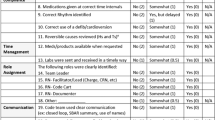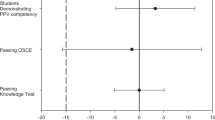Abstract
Objective:
The Neonatal Resuscitation Program (NRP) has transitioned to a simulation-based format. We hypothesized that immersive simulation differentially impacts similar trainee populations’ resuscitation knowledge, procedural skill and teamwork behavior.
Study Design:
Residents from NICU and non-NICU programs were randomized to either control or a booster simulation 7 to 10 months after NRP. Procedural skill and teamwork behavior instruments were validated. Individual resident’s resuscitation performance was assessed at 15 to 18 months. Three reviewers rated videos.
Result:
Fifty residents were assessed. Inter-rater reliability was good for procedural skills (0.78) and team behavior (0.74) instruments. The intervention group demonstrated better procedural skills (71.6 versus 64.4) and teamwork behaviors (18.8 versus 16.2). The NICU program demonstrated better teamwork behaviors (18.6 versus 15.5) compared with non-NICU program.
Conclusion:
A simulation-enhanced booster session 9 months after NRP differentiates procedural skill and teamwork behavior at 15 months. Deliberate practice with simulation enhances teamwork behaviors additively with residents’ clinical resuscitation exposure.
This is a preview of subscription content, access via your institution
Access options
Subscribe to this journal
Receive 12 print issues and online access
$259.00 per year
only $21.58 per issue
Buy this article
- Purchase on Springer Link
- Instant access to full article PDF
Prices may be subject to local taxes which are calculated during checkout
Similar content being viewed by others
References
American Academy of Pediatrics, American College of Obstetricians and Gynecologists. In: Gilstrap LC, Oh W (eds). Guidelines for Perinatal Care, 5th edn. American Academy of Pediatrics: Elk, Grove Village, IL, USA, 2002, 187.
American Heart Association American Academy of Pediatrics. 2005 American Heart Association Guidelines for CPR and Emergency Cardiovascular Care of Pediatric and Neonatal Patients: Neonatal Resuscitation Guidelines. Pediatrics 2006; 147 (5): e1029–e1038.
Falck AJ, Escobedo MB, Baillargeon JG, Villard LG, Gunkel JH . Proficiency of pediatric residents in performing neonatal endotracheal intubation. Pediatrics 2003; 112 (6): 1242–1247.
Feigin RD, Drutz JE, Smith EOB, Collins CR . Practice variations by population: training significance. Pediatrics 1996; 98 (2): 186–190.
Leone TA, Rich W, Finer NN . Neonatal intubation: success of pediatric trainees. J Pediatr 2005; 146 (5): 638–641.
Perlman J, Risser R . Cardiopulmonary resuscitation in the delivery room. Associated clinical events. Arch Pediatr Adolesc Med 1995; 149 (1): 20–25.
Aziz K, Chadwick M, Downton G, Baker M, Andrews W . The development and implementation of a multidisciplinary neonatal resuscitation team in a Canadian perinatal centre. Resuscitation 2005; 66 (1): 45–51.
Patterson M, Moyer M, LeMaster T, Pio B . Effect of a focused paramedic educational intervention on the acquisition and retention of airway management skills in the pediatric patient [Abstract]. Soc Pediatr Res 2005; 57: 1874.
Curran VR, Aziz K, Oyoung S, Bessel C . Evaluation of the effect of a computerized training simulator (anakin) on the retention of neonatal resuscitation skills. Teach Learn Med 2004; 16 (2): 157–164.
Levitt C, Kaczorowski J, Outerbridge E, Jiminez V, Connoly B, Slapcoff B . Knowledge gained following neonatal resuscitation program courses. Family Med 1996; 28: 403–406.
Semeraro FSL, Cerchiari EL . Retention of CPR performance in anaesthetists. Resuscitation 2006; 68 (1): 101–108.
Boet S BB, Naik VN, Siu LW, Riem N, Chandra D, Bould MD et al, Complex procedural skills are retained for a minimum of 1 yr after a single high-fidelity simulation training session. Br J Anaesth 2011; 107 (4): 533–539.
Madar J . Clinical risk management in newborn and neonatal resuscitation. Semin Fetal Neonatal Med 2005; 10 (1): 45–61.
Cappelle C, Paul R . Educating residents: the effects of a mock code program. Resuscitation 1996; 31 (2): 107–111.
Pliego JF W-JH, Rajab MH, Browning JL, Fothergill RE . Ob/Gyn boot camp using high-fidelity human simulators: enhancing residents’ perceived competency, confidence in taking a leadership role, and stress hardiness. Simul Healthcare 2008; 3 (2): 82–89.
Thomas E, Sexton J, Lasky R, Helmreich R, Crandell D, Tyson J . Teamwork and quality during neonatal care in the delivery room. J Perinatol. 2006; 26: 163–169.
Carbine D, Finer N, Knodel E, Rich W . Video recording as a means of evaluating neonatal resuscitation performance. Pediatrics 2000; 106: 654–658.
Halamek L, Kaegi D, Gaba D, Sowb Y, Smith B, Smith B et al. Time for a new paradigm in pediatric medical education: teaching neonatal resuscitation in a simulated delivery room environment. Pediatrics 2000; 106 (4): e45.
Murphy A, Halamek L . Educational Perspectives: Simulation-based Training in Neonatal Resuscitation. NeoReviews 2005; 6 (11): e489–e492.
Short J . Textbook of Neonatal Resuscitation, 5th edn. American Academy of Pediatrics and American Heart Association: Elk Grove Village, IL, USA, 2006.
Kattwinkel J . Textbook of Neonatal Resuscitation, 6th edn. American Academy of Pediatrics and American Heart Association: Elk Grove Village, IL, USA, 2011.
Heukelom JNV, Begaz T, Treat R . Comparison of postsimulation debriefing versus in-simulation debriefing in medical simulation. Sim Healthcare 2010; 5: 91–97.
Dismukes R, Smith G . Facilitation and Debriefing in Aviation Training and Operations . Ashgate: Aldershot; UK, 2000.
A New Vision for Pediatric and Perinatal Education at Center for Advanced Pediatric and Perinatal Education (http://cape.lpch.org/).
Fanning RM, Gaba DM . The role of debriefing in simulation-based learning. Simul Healthcare 2007; 2 (2): 115–125.
Gaba D, Howard S . Assessment of clinical performance during simulated crises using both technical and behavioral ratings. Anesthesiology 1998; 89 (1): 8–18.
Weller J, Bloch M . Evaluation of high fidelity patient simulator in assessment of performance of anaesthetists. Br J Anaesth 2003; 90 (1): 43–47.
Van der Heide P, Toledo-Eppinga L, van der Heide M, van der Lee J . Assessment of neonatal resuscitation skills: a reliable and valid scoring system. Resuscitation 2006; 71: 212–221.
Adler MD, Trainor JL, Siddall VJ, McGaghie WC . Development and validation of high fidelity patient simulator case scenarios for pediatric resident evaluation [Abstract]. Soc Pediatr Res 2006; 7: 182–186.
Brett-Fleegler MB, Vinci RJ, Weiner DL, Harris SK, Shih MC, Kleinman ME . A simulator-based tool that assesses pediatric resident resuscitation competency. Pediatrics 2008; 121 (3): e597–e603.
Overly F, Sudikoff S, Shapiro M . High fidelity medical simulation as an assessment tool for pediatric residents' airway management skills. Pediatr Emerg Care. 2007; 23 (1): 11–15.
Frankel A, Gardner R . Using the Communication and Teamwork Skills (CATS) Assessment to measure health care team performance. Jt Comm J Qual Patient Saf 2007; 33 (9): 549–558.
Training materials from Center for Advanced Pediatric Education, Palo Alto.
Halamek L . The simulated delivery-room environment as the future modality for acquiring and maintaining skills in fetal and neonatal resuscitation. Semin Fetal Neonatal Med. 2008; 13: 448–453.
Sawyer T, Sierocka-Castaneda A, Chan D, Berg B, Lustik M, Thompson M . Deliberate practice using simulation improves neonatal resuscitation performance. Simul Healthcare 2011; 6 (6): 327–336.
Campbell D, Barozzino T, Farrugia M, Sgro M . High-fidelity simulation in neonatal resuscitation. Paediatr Child Health 2009; 1 (14): 19–23.
Yaeger KA, Halamek LP, Coyle M, Murphy A, Anderson J, Boyle K et al. High-fidelity simulation-based training in neonatal nursing. Adv Neonatal Care 2004; 4 (6): 326–331.
Thomas EJ, Williams AL, Reichman EF, Lasky RE, Crandell S, Taggart WR . Team Training in the Neonatal Resuscitation Program for Interns: teamwork and quality of resuscitations. Pediatrics 2010; 125 (3): 539–546.
Acknowledgements
We acknowledge the generous contributions of all the residents who participated, as well as MaryAnn Garrin, Dan Gingras, Beau Abar, Lynne Dansereau, Joe McNamara, Joe Bliss and Abbot Laptook. This work was supported by Department of Pediatrics, Women & Infants' Hospital.
Author information
Authors and Affiliations
Corresponding author
Ethics declarations
Competing interests
The authors declare no conflict of interest.
Additional information
Supplementary Information accompanies the paper on the Journal of Perinatology website
Supplementary information
Rights and permissions
About this article
Cite this article
Bender, J., Kennally, K., Shields, R. et al. Does simulation booster impact retention of resuscitation procedural skills and teamwork?. J Perinatol 34, 664–668 (2014). https://doi.org/10.1038/jp.2014.72
Received:
Revised:
Accepted:
Published:
Issue Date:
DOI: https://doi.org/10.1038/jp.2014.72
This article is cited by
-
E-learning use in the review of neonatal resuscitation program in physicians: a scoping review
Journal of Perinatology (2022)
-
Early or late booster for basic life support skill for laypeople: a simulation-based randomized controlled trial
Canadian Journal of Emergency Medicine (2022)
-
A phenomenological study of the use of 360° Virtual Reality (VR) video in pediatric and neonatal resuscitation training
Health and Technology (2022)
-
Effectiveness of self-re-learning using video recordings of advanced life support on nursing students’ knowledge, self-efficacy, and skills performance
BMC Nursing (2021)
-
Teamwork, communication and resident leadership at resident-attended, neonatal delivery room resuscitations
Journal of Perinatology (2021)



